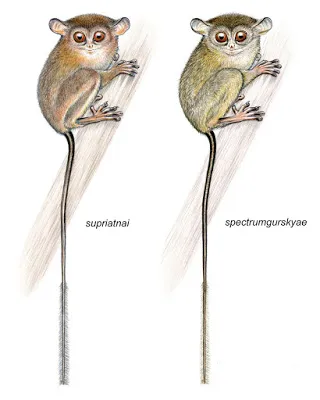Two New Species of Googly-Eyed Tarsiers Discovered in Indonesia
The tiny tree dwellers are the 80th and 81st primates discovered since 2000
/https://tf-cmsv2-smithsonianmag-media.s3.amazonaws.com/filer/d9/45/d945a488-54c2-419a-a19e-76e4da1dd62f/tarsier_2.jpg)
Researchers have discovered two new species of tarsiers—a type of tiny, giant-eyed primate—on the island of Sulawesi in Indonesia. As Bruno Vander Velde reports for Conservation International, these two species of “forest goblins” were named in honor of two conservation scientists, dubbed Tarsius spectrumgurskyae and Tarsius supriatnai. Though the two animals look superficially similar, genetic data and their calls identify them as separate species. Researchers described the species in the journal Primate Conservation.
Tarsiers live in the islands of Southeast Asia, and as Rae Paoletta writes for Gizmodo, they look like a furry, "stoned Yoda." Most of tarsier species and subspecies are between four and six inches long, weighing in at three to six ounces. The little nocturnal primates live in trees and are able to leap up to 10 feet, feasting on insects, lizards and occasionally birds. But the most impressive aspect of tarsiers are their giant, saucer-like eyes. Because their eyes don’t move, the animals have developed the unusual ability to rotate their heads 360 degrees, which is unique among primates.
“These species probably have the largest eyes relative to the size of their head of all mammal species,” wildlife biologist Imogene Cancellare tells Paoletta. “The cone distribution in the retinas of these huge eyes makes tarsier eyes among the most sensitive in the world—they can absorb a lot of light, which is how these nocturnal species navigate their habitat.”

While the two new species of tarsiers are interesting, the researchers have used the discoveries to also raise awareness of tarsier and primate conservation in general. “These two new species are the 80th and 81st primates new to science described since 2000—this represents about 16 percent of all primate species known, and is indicative of how little we know of our planet’s unique and wonderful biodiversity,” Russ Mittermeier, a primatologist with Conservation International and one of the study’s authors, tells Vander Velde. “If we haven’t even gotten a handle on the diversity our closest living relatives, which by comparison are relatively well-studied, imagine how much we still have to learn about the rest of life on Earth.”
As Carrie Arnold writes for National Geographic, the new discoveries raise the number of tarsier species found on Sulawesi and its surrounding islands to 11. But the World Wildlife Fund reports half of the forests on the island have been logged and most of the remaining forest is severely fragmented.
“Sulawesi, like many regions in the tropics, is facing a conservation crisis. The big difference between Sulawesi and elsewhere is that owing to the complex geological history of the island, we have likely underestimated the true diversity of species there by an order of magnitude or more,” Myron Shekelle, tarsier expert and lead author of the paper tells Mike Gaworecki at Mongabay. “Thus, each time habitat loss causes the extinction of what we might have thought was one species, the actual number of extinctions might be 10 times greater than that.”
Shekelle tells Gaworecki that the new species probably qualify as vulnerable under the IUCN’s classification for endangered species, and depending on statistics about habitat destruction, the two species may earn official Endangered status.